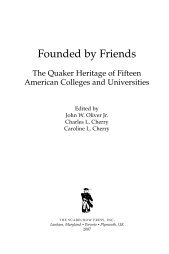Separate Realities: The Dream and the Iceberg - Scarecrow Press
Separate Realities: The Dream and the Iceberg - Scarecrow Press
Separate Realities: The Dream and the Iceberg - Scarecrow Press
You also want an ePaper? Increase the reach of your titles
YUMPU automatically turns print PDFs into web optimized ePapers that Google loves.
76 Chapter 2<br />
as <strong>the</strong> later chapters illustrate, we see privileged-class members as much more<br />
conscious of <strong>the</strong>ir collective class interests, more cohesive in pursuing <strong>the</strong>m,<br />
<strong>and</strong> in possession of much greater (<strong>and</strong> more unified) organizational resources<br />
than <strong>the</strong> working class. <strong>The</strong> net result is that, compared with <strong>the</strong> working<br />
class, <strong>the</strong> privileged class is much more aware of, <strong>and</strong> able to effectively<br />
pursue <strong>and</strong> realize, its common class interests.<br />
Class War in America<br />
<strong>The</strong> war that nobody talks about—<strong>the</strong> overwhelmingly one-sided class war—<br />
is being waged all across America. Guess who’s winning.<br />
—Bob Herbert, New York Times, June 6, 2005<br />
Nowhere is <strong>the</strong> reality of conflicting class interests, privileged-class consciousness,<br />
<strong>and</strong> <strong>the</strong> overwhelming power of superclass-dominated organizational<br />
resources more apparent than in <strong>the</strong> story behind <strong>the</strong> transformation of<br />
<strong>the</strong> American class system in <strong>the</strong> period from <strong>the</strong> 1970s to <strong>the</strong> present. <strong>The</strong><br />
trends of class polarization, downward mobility, <strong>and</strong> class secession are <strong>the</strong> direct<br />
result of policy decisions made <strong>and</strong> sponsored by superclass-controlled<br />
organizations over <strong>the</strong> past thirty years that collectively represent nothing less<br />
than total class war. Although varying explanations exist for <strong>the</strong> current configuration<br />
of <strong>the</strong> American class system, none approaches <strong>the</strong> explanatory<br />
power of a class-war analysis. Although <strong>the</strong> details of <strong>the</strong> story are complex,<br />
<strong>the</strong> main actors, events, <strong>and</strong> policies underlying it are stunningly simple. <strong>The</strong>y<br />
are fundamentally grounded in conflicting class interests <strong>and</strong> linked to <strong>the</strong> dynamics<br />
of an almost totally one-sided class war sponsored <strong>and</strong> directed by <strong>the</strong><br />
superclass <strong>and</strong> driven by corporate resources.<br />
<strong>The</strong> story behind today’s new class society begins in <strong>the</strong> late 1960s <strong>and</strong><br />
early 1970s. Several progressive political <strong>and</strong> social movements supported<br />
by organized labor, consumer <strong>and</strong> environmental organizations, <strong>and</strong> o<strong>the</strong>r<br />
reform-minded groups during this period led to an expansion of New<br />
Deal–based national policies that effectively increased opportunities for—as<br />
well as <strong>the</strong> economic, occupational, <strong>and</strong> physical well-being of—workingclass<br />
Americans. Such policies included numerous Great Society programs<br />
such as Medicare <strong>and</strong> Medicaid, as well as several new federal regulatory acts<br />
in six major areas, including consumer products, discrimination in employment,<br />
traffic safety, consumer finance, job safety, <strong>and</strong> <strong>the</strong> environment. 164<br />
Among <strong>the</strong>se acts were groundbreaking measures such as <strong>the</strong> 1966 Coal<br />
Mine Safety Act, <strong>the</strong> 1969 National Environmental Policy Act, <strong>and</strong> <strong>the</strong> 1970<br />
Occupational Health <strong>and</strong> Safety Act. For workers, <strong>the</strong> net effect of <strong>the</strong> progressive<br />
legislation enacted in <strong>the</strong> 1960s <strong>and</strong> early 1970s was a welcome expansion<br />
of <strong>the</strong> U.S. welfare state.<br />
Members of <strong>the</strong> superclass viewed pro-worker policy developments with<br />
fear <strong>and</strong> loathing: “<strong>The</strong> expansion of <strong>the</strong> welfare state in <strong>the</strong> 1960s <strong>and</strong> 1970s
















